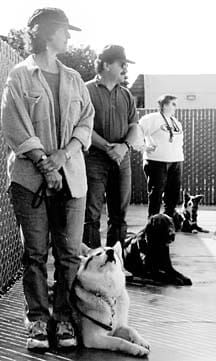Dog training classes vary widely in style and quality of instruction. It is important to do research and make an informed choice before selecting a trainer. Before putting your dog’s future in a trainer’s hands, we recommend that you ask a lot of questions.
First, though, you have to decide what you want from a training class. Class styles vary, with the two primary approaches being the military-style precision training traditionally used for showing in the obedience ring, and family dog classes that are more concerned with teaching canine good manners and social skills.
The easiest way to tell the difference between the two is to ask what equipment is required. If the answer is “a choke chain, slip collar, training collar, or prong collar,” the class is probably the more formal obedience class that relies on the use of force and physical correction. If the answer is “a flat buckle collar or a headcollar,” you have found the more relaxed family dog class that uses positive reinforcement, rewards (treats) and praise – rather than jerks on a collar – to train the dog.

Do Your Homework
When you find the style that appeals to you, watch a class before you enroll. Dogs and owners should appear to be enjoying themselves; if they aren’t, you probably won’t either. Make sure you like the methods the trainer uses. If you see something that makes you uncomfortable, a harsh punishment, for example, ask the trainer after the class whether what you witnessed is par for her course. She might regard the method as “necessary” for most dogs – or a rare occurrence she felt forced to try after failing with other methods. Trust your instincts about her response.
There are very few, if any, reputable dog trainer certification programs. While ongoing education is vital for a professional trainer, a brief certification course cannot provide a would-be trainer with the necessary years of dog handling and teaching experience. Look for a trainer who has had experience handling hundreds or thousands of dogs, and has taught classes for at least two years. Ask where she got her training. Her combined experiences should total at least several years of exposure to a variety of breeds and mixture of breeds. Find out what other activities are available, if not through her, then through other trainers and dog clubs in the area. Ask if her training methods will prepare you for the other activities that capture your interest.
You Get What You Pay For
Be cautious of classes offered by dog clubs and large chain pet stores. They are often less expensive than those taught at privately owned dog training schools, but they are also frequently taught by their members, who may or may not have any previous teaching experience. These classes are often large, with little individual attention given. Also, many club classes use force-based training only. Chain pet stores may advertise positive reinforcement, but often hire novice trainers with little or no training knowledge or experience. They also tend to have a high turnover, since quality trainers can do better on their own.
The cost of dog training can vary widely. Free courses can sometimes be found through clubs or city recreation departments (just remember, you get what you pay for). Group classes that meet once a week can range from as little as $45 to $125 or more for a six- to eight-week course. (The price generally reflects cost of living in the area.) Expect an average of six to eight people and their dogs in the class; larger classes should have assistant trainers to help the trainer offer each of the students at least a little individual attention. This type of multi-week course is almost always paid for in advance.
Many trainers also offer private instruction at their school or, sometimes, at your home. Expect to pay from $45 to $150 an hour for this type of one-on-one session. During a one-hour consultation for a specific behavior challenge, your trainer should demonstrate one or more approaches for resolving the behavior and watch you apply the techniques. You can also expect her to offer options for an ongoing training program for you and your dog.
Going to Class
Once you select a trainer, but before you attend the first class, try to have a brief discussion with the person in charge. Make sure he or she is aware of your goal for the class, to prevent any misunderstandings regarding the intensity (or lack thereof!) with which you pursue perfection in your dog.
Finally, don’t hesitate to excuse yourself and walk out of a class if you are told to do something to your dog that makes you feel uncomfortable. It can be difficult and embarrassing to disagree with a trainer, especially in front of an entire class full of her devotees, but remember, it’s your relationship with your dog and his trust in you that is important, not someone else’s opinion. There will always be another class and another day to get it right.






